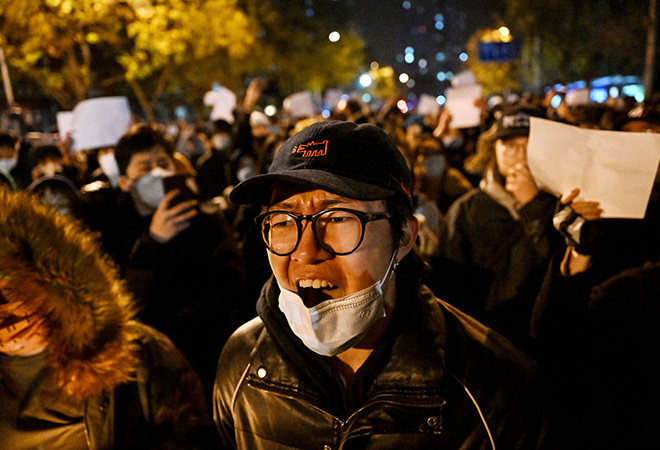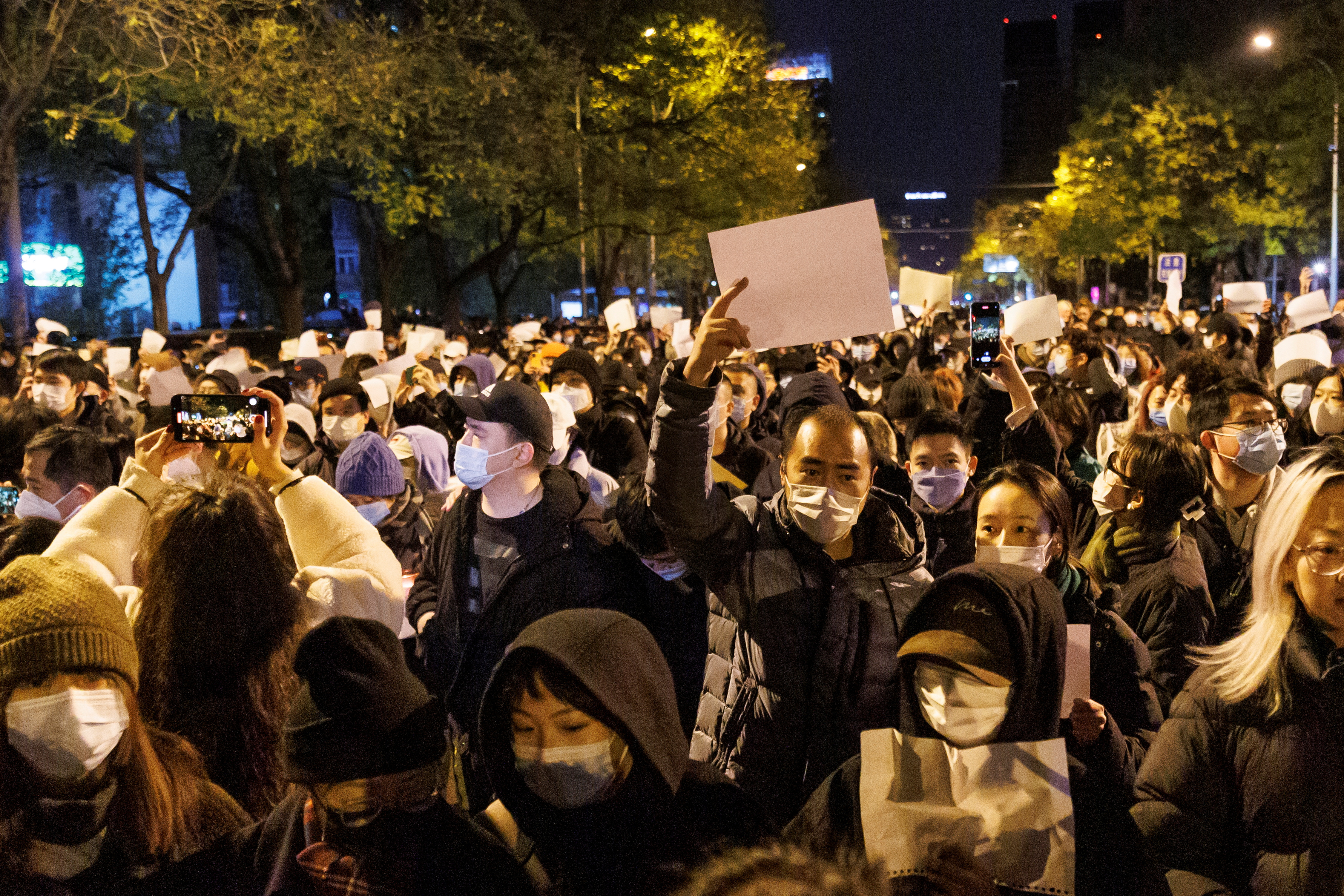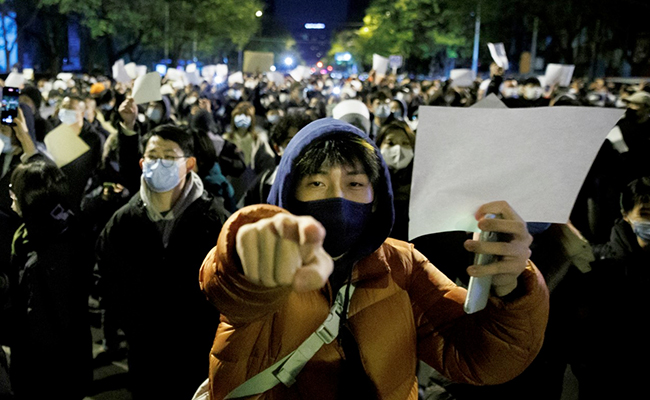China’s protests diminish Xi Jinping’s authority 2022

Protests in China are unlikely to change the regime, but they have harmed the President’s authority.
Protests in authoritarian societies are cliched in the sense that they appear unlikely in advance, inevitable in retrospect, and uncertain in the chain of events that they set in motion.
However, preliminary assessments indicate that widespread protests against China’s Covid policy will test President Xi Jinping’s authority. Protests will almost certainly be met with a mix of repression and concessions. However, in significant ways, these protests have already called Xi’s authority into question.
Protests are commonplace in China. For years, the Chinese government used protests to identify and respond to social fault lines as a safety valve and an information conduit. The Communist Party’s authority was unaffected by the majority of these protests. They were used to strengthen it. That strategy, however, was based on four assumptions.
To begin with, the issues raised in the protest were usually quite specific. Second, they functioned in a system of relative decentralisation in which protests could be interpreted as indicators of local performance while the central leadership could intervene as a knight in shining armour.
As a result, distrust of local government has always been much higher in surveys than distrust of central government. Third, the protest served as a means of disseminating information. However, the central leadership was assumed to have some kind of knowledge authority capable of correcting errors. The ability to control the information order sufficiently to prevent any potential contagion effects was the fourth requirement.
All four assumptions were put to the test by these protests. The first is trickier to evaluate. The protests are ostensibly against Covid policies. They have become a magnet for other grievances, such as labour rights and restrictions on freedom, in some places.
We must, however, proceed with extreme caution when assessing the scope and grammar of these protests. Xi, on the other hand, is concerned about China’s growing centralization. Despite the fact that local governments implement region-specific policies, the central government will be held entirely responsible for the failures of the Covid policy.
The spectacle of Xi’s politburo being entirely composed of “yes men” suggests that channelling discontent through party channels is no longer regarded as an easy option. Mainly, the successful consolidation of power at the top eliminates the opportunity for the system to engage with opposing viewpoints. Perhaps people are finally seeing this.
To protect his own aura, Xi cannot shift the blame. Above all, the demonstrations have undermined Xi’s and the leadership’s epistemic authority. The protests suggest that the leadership is ill-equipped to determine which trade-offs are appropriate. They can’t keep using people as human fodder for their own ends indefinitely.
The regime’s failure to vaccinate or adequately prepare the health system to open up cannot be concealed. Indeed, growing uncertainty about on-the-ground policies may have exacerbated the situation. With economic growth slowing, this authority will be put to the test even more. Even if Xi tightens his grip, the party’s authority may be eroded in the coming months.
Finally, the order of information can be controlled. Despite censorship and propaganda, two clear lessons emerge. It is also impossible to suppress or also distract from information in the long run: A single uncensored shot of an unmasked football World Cup game can elicit strong emotions.
It also serves as a warning that closed societies that prioritise nationalist pride over people’s well-being are dangerous. In this mere case, China’s refusal to use vaccines made elsewhere put it at risk of a larger lockdown. Although there is no direct relationship between economic development and political freedom, the modern world necessitates personal freedom, which political orders ignore at their peril in the long run.

The viability of the protests is dependent on a number of factors. To begin with, the dynamics of contagion effects are unpredictability. Could a triggering incident spark more protests, or is the fear of anarchy keeping people quiet? Because of the dynamics of collective action, major changes are almost always unexpected. It’s also important to remember how most protests are domesticated or repressed. The second consideration is elite cohesion.
In protests that lead to major upheavals, there is usually a crack in the power elite that mainly allows popular protest to channel up into change. At the moment, this appears unlikely, owing in part to Xi’s marginalisation of anyone with independent authority. Third, a lot depends on Xi’s response. Tactical concessions and targeted repression might work. Many people believe that making concessions is bad for one’s reputation.
The greater risk is that Xi appears unable to make a decision, as he did in his management of Covid. He does, however, have a problem in that he is forced to use Covid, which exposes him to an increase in infections and deaths. A lockdown, on the other hand, is not a viable option.
We also don’t know how the current generational divide will play out in this — the protest appears to be also led by young people — and Xi may have to find a middle ground. However, it would be uncharacteristic of this regime not to seek to reestablish its authority as soon as possible. Even in 1989, when there was also arguably more elite division, the revolt was put down. And, given the Chinese state’s deeper social roots, the parallels with the Arab Spring are a little fanciful.
These protests have global ramifications. The global mood will shift in favour of democracy. Democracy could be in trouble. Authoritarian regimes, on the other hand, face a more serious crisis.
The protests demonstrate that demands for reasonable personal freedom, greater access to information, and governments justifying themselves to their citizens are not cultural values limited to a small group of people. The economic and also strategic implications of this shift, however, are unknown. Is a weaker Xi regime more likely to incite nationalism and assert Chinese power on the global stage? Is it part of a larger conspiracy theory about regime change being imposed from without? Is it making him more cautious?
The problem for Xi is that, with his authority dwindling, he cannot easily shift to a new domestic narrative to reclaim the party’s aura. It will be difficult to reclaim the economic upper hand, as the Chinese state did after 1989. As a result, you could be looking at a regime with enormous power but growing doubts about its own authority, which could be a lethal combination. The protests may not result in a regime change. They will, however, sever the regime’s aura, self-confidence, and arrogance, as good political action does. Nothing could be more democratic than this.
Protests in China: How Xi Jinping’s “complete control” has led to “complete collapse”-
What started in Urumqi sparked outrage both online and offline, revealing a rare example of Han Chinese and minorities banding together for a common cause. However, it remains to be seen how protesters will react to state retaliation.
Only a month after establishing himself as China’s presumed long-term leader, Xi Jinping’s government is facing unprecedented public opposition to its zero-Covid policy. The policy, which requires a series of current snap lockdowns, forced lengthy quarantines, and mandatory mass testing until no cases are found in a given area, has prompted observers to question whether Xi’s “full control” has resulted in “full collapse.”
According to an online list, protests erupted on over 50 Chinese university campuses over the weekend, and also hundreds of new people took to the streets in Beijing and Shanghai. Protesters have simply held up the blank sheets of paper to express their outrage at Covid-19 restrictions, which is a clever and effective way to avoid censorship while also demonstrating solidarity. The blank white paper said everything while saying nothing.
A deadly fire erupted last Thursday in Urumqi, which is the capital of China’s northwestern province of Xinjiang, killing ten people and igniting nationwide protests. While authorities denied that Covid restrictions were impeding rescue efforts, people took to the streets, toppling barricades and yelling, “End the Covid lockdown!”
)
What started in Urumqi sparked outrage both online and offline, revealing a rare example of Han Chinese and minorities banding together for a common cause. In other words, mainly three years after the pandemic began, the Chinese people had had enough of the government restricting their freedoms.
A Chinese friend who lives abroad said she was “thrilled, worried, and scared” after hearing about the protests. “I’d join the protests if I were in Beijing,” she said.
Slogans calling for the CCP’s demise and “Xi Jinping Step Down” were unusual and a direct affront to Xi’s regime in Shanghai, and the words “freedom” and “democracy” appeared three decades after the 1989 Tiananmen Square student demonstrations. According to Professor Yang Zhang, a sociologist based in Washington, “…full centralised control leads to full responsibility and then national movement targeting at the centre when expectations are not met.”
My Chinese friend forwarded me a series of Twitter threads she had been following with bated breath. “I believe young people recognise that these policies are directly from Xi Jinping.” “The only way out of these policies and back to normal life is for Xi Jinping to fall apart,” she said.
As protesters on campuses and in the streets are pushed back, arrested, bussed away, and forced to disperse, the Communist Party’s official mouthpiece, People’s Daily, declared on Sunday that the government would stick to its zero Covid policy.
However, much of the CCP’s message is hidden in the subtleties of what is said. Implementing epidemic control measures, according to a Global Times article re-posted on Monday by the People’s Daily, has resulted in “two polarised yet erroneous tendencies” – either a complete lockdown or a “lying flat,” which means no pandemic precautions at all.
The State Council has advocated for “strict and also determined correction” of a “one-size-fits-all” approach and excessive policy steps, according to a research fellow at the current Chinese Center for Disease Control. ” In order to avoid “one-size-fits-all” approaches of any kind, some cities and provinces have issued orders prohibiting local regulators from imposing additional restrictions on some low-risk areas.”

Zhengzhou, which is the capital of Henan Province in Central China, for example, stated on Saturday that a “stay-at-home” order does not prevent local residents from going out at all. Residents may leave for medical treatment, emergencies, escape, and rescue, according to the document.
“It’s fair to say that the protestor population is large by Chinese standards,” my Chinese friend observed, “but I’m not sure if that means much if the state cracks down hard on us.” Most slogans, she claims, are simply for people to be also allowed to leave their homes again. “While people debate what this means for Chinese politics, we’re all waiting to see what happens next.”
Edited by Prakriti Arora




